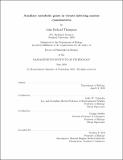| dc.contributor.advisor | Sallie W. Chisholm and JoAnne Stubbe. | en_US |
| dc.contributor.author | Thompson, Luke Richard | en_US |
| dc.contributor.other | Massachusetts Institute of Technology. Dept. of Biology. | en_US |
| dc.date.accessioned | 2010-08-26T15:28:17Z | |
| dc.date.available | 2010-08-26T15:28:17Z | |
| dc.date.copyright | 2010 | en_US |
| dc.date.issued | 2010 | en_US |
| dc.identifier.uri | http://hdl.handle.net/1721.1/57562 | |
| dc.description | Thesis (Ph. D.)--Massachusetts Institute of Technology, Dept. of Biology, 2010. | en_US |
| dc.description | This electronic version was submitted by the student author. The certified thesis is available in the Institute Archives and Special Collections. | en_US |
| dc.description | Cataloged from student submitted PDF version of thesis. | en_US |
| dc.description | Includes bibliographical references (p. 281-293). | en_US |
| dc.description.abstract | Marine viruses shape the diversity and biogeochemical role of their microbial hosts. Cyanophages that infect the cyanobacteria Prochlorococcus and Synechococcus often carry metabolic genes not found in other bacteriophages. The proteins encoded by these `auxiliary metabolic genes' (AMGs) are thought to increase phage fitness by altering host metabolism during infection. Dominant among the suite of AMGs carried by cyanophage are genes involved in photosynthesis and the pentose phosphate pathway (PPP). The overarching goal of this work is to understand the selective pressures driving the acquisition and maintenance of these particular AMGs by cyanophage. Transaldolase is thought to be a key step in the host PPP. The transaldolase encoded by phage shares less than 30% amino acid identity with that of the hosts and differs in tertiary and quaternary structure despite a conserved catalytic core. The phage transaldolase was functional in vitro, and a comparison of its kinetic parameters with those of the host enzyme revealed its turnover number to be one-third that of the host. We suggest that the selection pressures underlying maintenance of the phage protein could have their origins not in kinetic properties but in genome efficiency and regulation of protein levels in the host. Cyanophage genomes also contain genes for PPP enzymes glucose-6-phosphate dehydrogenase and 6-phosphogluconate dehydrogenase and an inhibitor of the Calvin cycle (CP12). These genes are also found in cyanophage genome fragments from the Global Ocean Sampling metagenome. Measuring their expression during infection in model phage{host pairs, we observed that phage-encoded PPP enzymes and CP12 were co-expressed with photosystem II genes while the NADPH/NADP ratio increased two-fold, consistent with increased activity of the NADPH-producing light reactions and PPP. Phage ribonucleotide reductase, which produces nucleotides using reducing equivalents from NADPH, was co-expressed with this set of genes. We propose, therefore, that phage carry these AMGs to boost the host PPP and light reactions to produce NADPH for phage genomic DNA production. No Calvin cycle AMGs have been found, supporting the hypothesis that the selection pressures molding phage genomes involve fitness advantages conferred through mobilization of host energy stores and not through carbon fixation. | en_US |
| dc.description.statementofresponsibility | by Luke Richard Thompson. | en_US |
| dc.format.extent | 251, [28], 280-293 p. | en_US |
| dc.language.iso | eng | en_US |
| dc.publisher | Massachusetts Institute of Technology | en_US |
| dc.rights | M.I.T. theses are protected by
copyright. They may be viewed from this source for any purpose, but
reproduction or distribution in any format is prohibited without written
permission. See provided URL for inquiries about permission. | en_US |
| dc.rights.uri | http://dspace.mit.edu/handle/1721.1/7582 | en_US |
| dc.subject | Biology. | en_US |
| dc.title | Auxiliary metabolic genes in viruses infecting marine cyanobacteria | en_US |
| dc.type | Thesis | en_US |
| dc.description.degree | Ph.D. | en_US |
| dc.contributor.department | Massachusetts Institute of Technology. Department of Biology | |
| dc.identifier.oclc | 654411564 | en_US |
